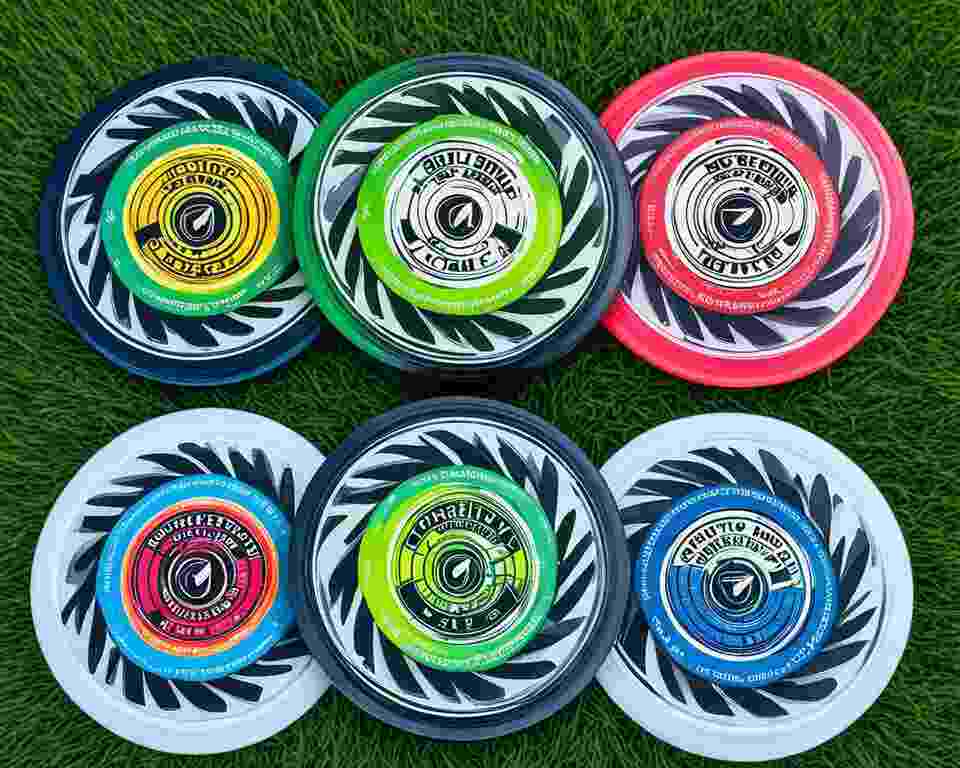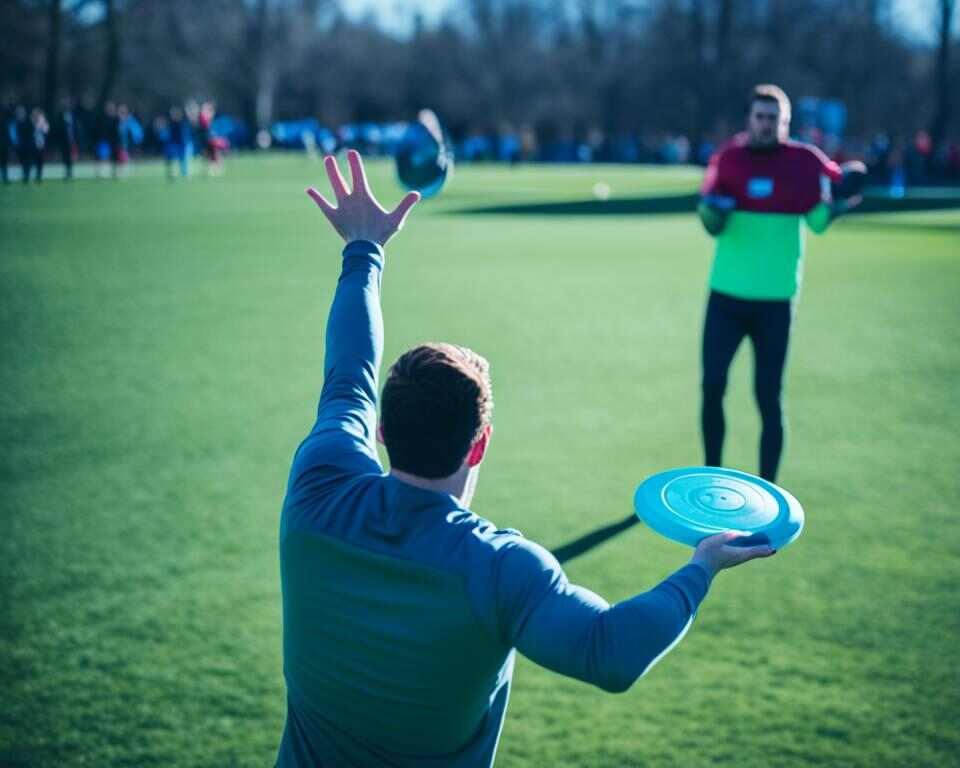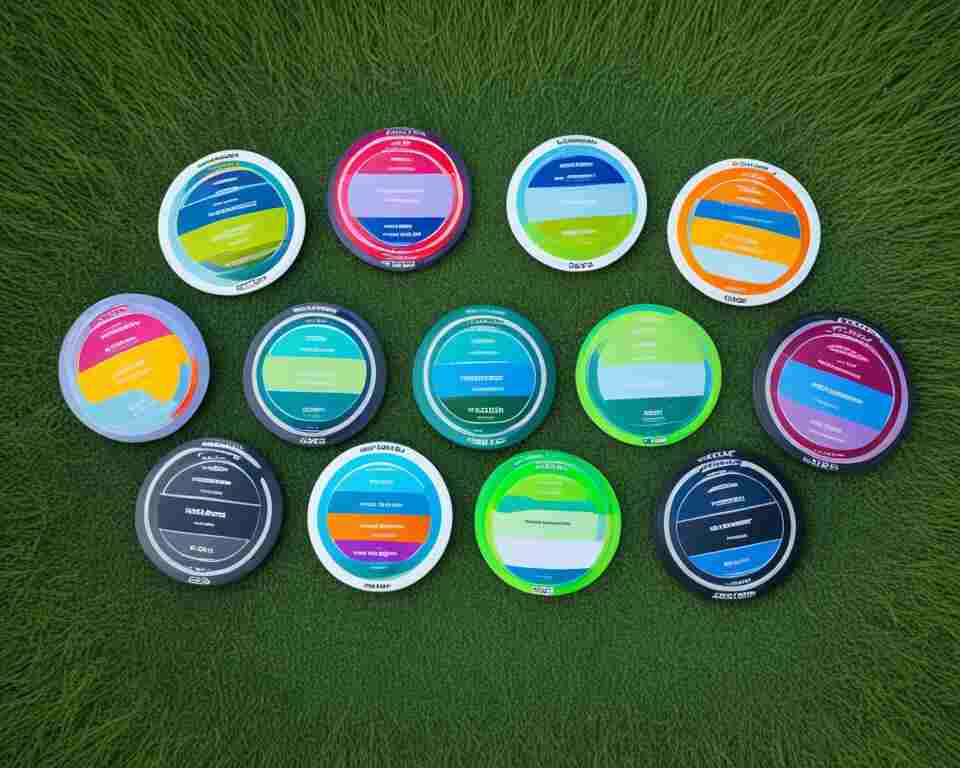Are you a beginner in the world of disc golf, wondering how to choose the right discs to improve your game? Look no further! In this comprehensive guide, I will walk you through everything you need to know about selecting disc golf discs for beginners.
From understanding the basics of disc types to exploring flight characteristics and factors that influence disc performance, you’ll be equipped with the knowledge to make informed choices that will enhance your disc golf experience.
Key Takeaways:
- Understand the basics of disc golf discs, including terminology and different disc types.
- Learn how to choose the right disc for your playing style and skill level.
- Explore the flight characteristics of disc golf discs and how they affect performance.
- Discover the significance of disc stability and its role in your game.
- Find out how to match disc types to your playing style.

Understanding the Basics of Disc Golf Discs
In this section, I will introduce beginners to the basics of disc golf discs. Understanding the terminology and different types of discs is essential for navigating the world of disc golf. Let’s dive in!
Disc Golf Terminology: From Drivers to Putters
Before we dig deeper into disc golf discs, let’s familiarize ourselves with some common terminology. In disc golf, discs are classified into different categories based on their purpose and flight characteristics.
One of the most common disc types in disc golf is drivers. Just like their name suggests, drivers are designed for long-distance shots and offer maximum distance potential. On the other hand, putters are designed for shorter and more accurate shots, offering better control and precision.
Other terms you may come across include midrange discs, which are versatile and suitable for various shot distances, and approach discs, which bridge the gap between drivers and putters and are great for approach shots.
Discovering Different Disc Types and Their Functions
Now, let’s explore the different disc types and their functions on the disc golf course.
1. Drivers: As mentioned earlier, drivers are designed for maximum distance. They typically have a sharper edge and a more aerodynamic shape, allowing them to slice through the air and cover long distances. Drivers come in different stability levels, ranging from understable to overstable, which affects their flight path.
2. Midrange Discs: Midrange discs are designed for shots that require more control and precision than drivers. They have a balanced flight path, offering a mix of distance and accuracy. Midrange discs are great for a wide range of shots, including approaches, controlled drives, and shorter drives.
3. Putters: Putters are the discs you will be using the most on the disc golf course. They are designed for accurate putting and short, controlled shots. Putters have a blunt edge and a shallow rim, allowing for a more comfortable grip and better accuracy.
By understanding the functions of different disc types, you can strategically choose the right disc for each shot and improve your overall performance on the disc golf course.
How to Choose the Right Disc for Disc Golf Beginners
When starting your disc golf journey, choosing the right disc can greatly impact your performance and enjoyment of the game. With the wide variety of discs available, it can be overwhelming for beginners to know where to start.
1. Understand Disc Weight:
One of the first considerations when selecting a disc is its weight. In general, lighter discs are easier to throw and provide more distance for beginners. A disc between 160-170 grams is a good starting point for most players.
2. Consider Disc Stability:
Disc stability refers to how a disc flies through the air. Beginners should look for discs with a stable or understable flight rating. These discs tend to fly straighter and are more forgiving for players with less power and technique.
3. Analyze Flight Characteristics:
Flight characteristics such as speed, glide, turn, and fade can greatly affect how a disc performs. Beginners should prioritize discs with lower speed ratings (8-10) for more control, higher glide ratings (4-7) for longer flights, and minimal turn and fade to prevent excessive left or right movement.
4. Consider Your Playing Style:
Take into account your personal playing style and strengths. If you have a naturally strong arm and can generate high throw speeds, you may benefit from discs with higher speed ratings. On the other hand, if you prefer a more controlled and accurate approach, discs with lower speed ratings will be more suitable for your game.
5. Seek Recommendations and Test Discs:
Don’t be afraid to seek recommendations from experienced disc golfers or try out different discs before making a purchase. Every player has different preferences, so it’s essential to find discs that feel comfortable in your hand and align with your throwing style.
By considering these factors and using the guidance provided, you’ll be able to choose the right disc that suits your playing style and helps you improve your disc golf game. Remember, disc selection is a personal journey, so don’t be discouraged if it takes some trial and error to find the perfect disc for you.
Examining Disc Golf Flight Characteristics
In the world of disc golf, understanding the flight characteristics of discs is crucial for players looking to improve their game. The unique design and construction of disc golf discs result in various flight patterns that can greatly impact their performance on the course.
The Role of Speed and Glide in Disc Selection
Disc speed refers to the velocity at which a disc needs to be thrown in order to achieve its optimal flight path. Speed is measured on a scale ranging from 1 to 14 in disc golf, with lower numbers indicating discs that require less power and higher numbers indicating discs that require more power to achieve maximum distance.
When selecting a disc, it’s important to consider your throwing speed and choose a disc with an appropriate speed rating to match your abilities.
Glide, on the other hand, refers to a disc’s ability to maintain lift and stay in the air for an extended period of time. A higher glide rating means the disc will stay in the air longer, providing increased distance potential.
Discs with higher glide are ideal for players seeking maximum distance on their throws, while lower glide discs are better suited for precise control and accuracy.
Turn and Fade: Decoding the Flight Rating System
Turn and fade are two important flight characteristics that are represented in the flight rating system used to describe disc golf discs. Turn refers to the tendency of a disc to curve in the opposite direction of its throwing hand (right-hand backhand throws curve to the left). It is measured on a scale from -5 to +1, with a negative number indicating a disc with high turn or a tendency to curve more, and a positive number indicating a disc with low turn or a tendency to fly straighter.
Fade, on the other hand, refers to the disc’s tendency to fade or curve back in the direction of its throwing hand at the end of its flight. Like turn, fade is also measured on a scale from 0 to 5, with higher numbers indicating a disc with more fade or a sharper curve at the end of the flight.
By understanding the flight characteristics of discs and the flight rating system, disc golfers can make more informed decisions when selecting discs for their game. Whether you’re looking for maximum distance, accuracy, or a combination of both, considering the speed, glide, turn, and fade of a disc will help you find the perfect disc for your playing style.
| Flight Characteristic | Description |
|---|---|
| Speed | The velocity at which a disc needs to be thrown for optimal flight. Ranges from 1 to 14, with higher numbers requiring more power. |
| Glide | The disc’s ability to maintain lift and stay in the air for an extended period. Higher glide ratings result in longer flight times. |
| Turn | The tendency of a disc to curve in the opposite direction of its throwing hand. Measured on a scale from -5 to +1, with negative numbers indicating higher turn. |
| Fade | The disc’s tendency to curve back in the direction of its throwing hand at the end of its flight. Measured on a scale from 0 to 5, with higher numbers indicating more fade. |
The Significance of Disc Stability for New Players

When it comes to disc golf, understanding disc stability is crucial for new players. Disc stability refers to the disc’s tendency to fly on a certain path, whether it’s a straight line, a gentle curve, or a sharp hook. It directly affects the disc’s flight trajectory and can greatly impact a player’s performance on the course.
Disc stability is commonly described through disc stability ratings, which consist of two numbers. The first number represents the disc’s high-speed stability, while the second number represents its low-speed stability. A disc with a higher first number tends to be more overstable, meaning it resists turning, while a disc with a lower number tends to be more understable, allowing it to turn and curve more easily.
For new players, disc stability is particularly significant because it can help them find discs that match their skill level and playing style. Overstable discs are generally recommended for beginners as they offer more control and predictability, making them easier to throw accurately. These discs are less likely to veer off the intended flight path and are more forgiving of release errors.
By choosing discs with the appropriate stability, new players can gain confidence in their throws and focus on improving their disc golf skills. As their technique and throwing power improve, they can gradually explore discs with different stability ratings to expand their repertoire and customize their game.
It’s important for new players to experiment with different disc stability ratings and find what works best for them. Trying out various discs and observing how they fly will help players develop a better understanding of their own preferences and throwing style.
Next, in section 6, we will discuss the process of matching disc types to a player’s playing style, including the differences between distance drivers and fairway drivers, as well as the crucial role of midrange discs and putters for beginners.
Matching Disc Types to Your Playing Style
In disc golf, choosing the right disc type for your playing style is crucial for enhancing your performance on the course. Different disc types are designed to fulfill specific roles, and understanding which discs are best suited to your style can greatly improve your game. Let’s explore the various disc types and their relevance to different playing styles.
Distance Drivers vs. Fairway Drivers
Distance drivers and fairway drivers are two main categories of disc golf discs used for long-distance throws. Distance drivers are designed for maximum distance and are ideal for players with powerful arm speeds. These discs have sharper rims and a wider diameter, allowing them to cut through the air and achieve exceptional distances.
Fairway drivers, on the other hand, offer less speed and distance but provide increased accuracy and maneuverability. They are suitable for players with moderate arm speeds or those who prioritize control over distance.
Why Midrange Discs and Putters Are Crucial for Beginners
For beginners, midrange discs and putters are essential components of their disc golf arsenal. Midrange discs have a shorter range than drivers but provide more control and versatility. They are designed for a wide range of shots, including approach shots and shorter drives. Beginners can benefit from these discs as they allow for better accuracy and predictability on the course.
Putters, on the other hand, are specifically designed for short-distance shots, including putting into the basket. They offer increased accuracy and touch, enabling better control around the putting green. Using midrange discs and putters effectively can significantly improve a beginner’s game and establish a solid foundation of skills.
Factors Influencing Disc Performance
When it comes to disc golf, several factors can significantly impact the performance of your disc. Understanding these factors is crucial for making informed decisions when selecting discs for optimal performance. In this section, we will explore two key factors that influence disc performance: the impact of plastic types and the role of disc weight and weather conditions.
Impact of Plastic Types on Disc Golf Discs
The type of plastic used in disc construction plays a significant role in the flight characteristics and durability of the disc. Different plastic types have varying levels of stiffness, grip, and durability, which can affect how the disc performs in different weather conditions and over time.
Some common plastic types used in disc golf discs include:
- DX: This plastic is known for its excellent grip and affordability. DX plastic discs tend to be less durable compared to other plastic types, but they provide good versatility for players of all skill levels.
- Star: Star plastic offers enhanced durability, which allows the disc to maintain its flight characteristics longer. It also provides a good balance of grip and firmness, making it suitable for both beginners and experienced players.
- Champion: Champion plastic is highly durable and retains its flight characteristics even after heavy use. It offers excellent stability and is ideal for players seeking consistent flights.
- Opto: Opto plastic is known for its durability and transparency. It provides a smooth release and offers reliable stability in different weather conditions.
- Pro: Pro plastic offers a good blend of durability and grip. It provides excellent control and is suitable for players of all skill levels.
By considering the characteristics of different plastic types, beginners can choose discs that align with their playing style and handle various weather conditions.
Disc Weight and Weather Conditions
Generally, lighter discs tend to have more glide and are easier to throw for beginners. They can also be beneficial in windy conditions as they are less affected by strong gusts. However, lighter discs might sacrifice some stability and control compared to heavier discs.
On the other hand, heavier discs offer increased stability and can handle stronger throws. They can be advantageous in calm weather conditions as they are less susceptible to deviations caused by wind. However, these discs may require more arm strength and control to achieve desired flight paths.
It’s important to consider your individual throwing power and the prevailing weather conditions when selecting the weight of your disc. Experimenting with different disc weights can help you find the optimal balance between distance, control, and stability.
Additionally, weather conditions such as wind speed and direction can have a significant impact on disc flight. Tailwinds can increase the glide and distance of a throw, while headwinds can create resistance and cause the disc to fade earlier. Crosswinds can affect the stability and accuracy of your throws.
By factoring in disc weight and understanding the influence of different weather conditions, beginners can choose the right discs that suit their individual throwing style and ensure consistent performance on the disc golf course.
Factors Influencing Disc Performance Table:
| Factors | Impact |
|---|---|
| Plastic Types | Affects flight characteristics and durability of the disc |
| Disc Weight | Affects flight path, stability, and control |
| Weather Conditions | Influences disc flight and stability |

Must-Know Tips for Beginner Disc Golfers
As a beginner disc golfer, it’s important to familiarize yourself with some essential tips that can help you improve your skills and make the most of your disc golf experience. Here are some must-know tips to get you started:
1. Practice your throwing technique: Spend time practicing your throwing technique to develop consistency and accuracy. Focus on proper grip, body positioning, and arm motion to achieve better throws.
2. Start with beginner-friendly discs: Choose discs that are specifically designed for beginners. These discs are typically more forgiving and easier to control, allowing you to learn the fundamentals of the game without getting frustrated.
3. Learn different throwing styles: Experiment with different throwing styles, such as backhand and forehand throws, to find out which one suits you best. Practice both styles to have versatility in your game.
4. Develop a strategy: Take time to understand the course layout and plan your shots accordingly. Consider factors such as wind direction, obstacles, and hole distances to make strategic decisions during play.
5. Master your putting skills: Putting is a crucial aspect of disc golf. Practice your short-distance throws to improve your accuracy and confidence when it comes to making putts.
6. Stay hydrated and take breaks: Disc golf can be physically demanding, so make sure to stay hydrated and take breaks when needed. Take care of your body to maintain your energy levels throughout the game.
7. Follow course etiquette: Familiarize yourself with the etiquette of disc golf courses. Respect other players, wait for your turn, and properly maintain the course by picking up trash and avoiding excessive noise.
8. Play with experienced players: Playing with more experienced disc golfers can provide valuable insights and tips for improving your game. Don’t be afraid to ask for advice or guidance.
By following these tips, you’ll be well on your way to becoming a skilled disc golfer. Remember to have fun, stay patient, and continuously strive to improve your game.
Choosing a Disc Golf Disc Based on Weight
Benefits of Heavy vs. Light Disc Golf Discs
When choosing a disc golf disc, one of the first decisions you’ll need to make is the weight of the disc. Both heavy and light discs offer their own unique advantages.
- Heavy Discs: Heavy discs, typically weighing around 170-175 grams, are known for their stability and ability to handle strong winds. They tend to be more predictable in their flight path, making them ideal for controlled shots and consistent throws.
- Light Discs: On the other hand, light discs, usually weighing around 150-165 grams, offer increased distance potential and better maneuverability. They require less power to throw, making them a favorite among beginners and players with slower arm speeds.
How Disc Weight Affects Flight in Various Conditions
The weight of a disc can affect its flight characteristics, especially when faced with different weather conditions. Here’s how disc weight interacts with various factors:
- Wind: In windy conditions, heavy discs are more resistant to being blown off their intended flight path. They are less likely to be affected by gusts, providing more stability and control. Lighter discs, on the other hand, may be more susceptible to wind and can be more difficult to control.
- Power: The weight of a disc can also impact the amount of power required to achieve maximum distance. A heavier disc may require more arm speed and power to generate the desired distance, whereas a lighter disc can be thrown with less force.
- Accuracy: For beginners or players with less throwing power, lighter discs can provide better accuracy due to their increased maneuverability. They are easier to control and can help players achieve more consistent throws.
To help you visualize the differences between heavy and light discs, take a look at the flight chart below:

| Heavy Discs | Light Discs | |
|---|---|---|
| Stability | High | Medium to Low |
| Wind Resistance | High | Medium |
| Distance Potential | Medium to High | High |
| Maneuverability | Low | High |
By considering the benefits of heavy and light discs and understanding how disc weight affects flight in various conditions, you can make an informed decision when choosing the right disc for your game. Remember to consider your skill level, throwing power, and the specific conditions you’ll be playing in to find the disc that suits your needs and preferences.
Building a Beginner’s Disc Golf Set
In this section, I will guide beginners on how to build a disc golf set that is suitable for their skill level and playing style. Building a disc golf set involves selecting the right discs, as well as other essential equipment such as a disc golf bag and accessories. By following my guidance, beginners will be able to assemble a well-rounded disc golf set that meets their needs.
To start building your disc golf set, the first step is to choose the right discs. As a beginner, it is recommended to start with a beginner’s disc golf set that includes a selection of discs suitable for players at your level.
When selecting discs, consider your throwing power and technique. If you have a slower arm speed, choose discs with lower speed ratings. Discs with lower speed ratings are easier to control and are more forgiving for beginners.
It is also important to consider the stability of the discs. Beginners typically benefit from using more understable discs, as they tend to fly straighter and require less power to achieve distance. As your skills improve, you can gradually introduce more stable discs into your set.
In addition to discs, a disc golf bag is an essential piece of equipment. Look for a bag that is large enough to hold your discs comfortably, with additional storage pockets for accessories such as a water bottle, towels, and snacks. A backpack-style bag is a popular choice among disc golfers for its comfort and functionality.
When it comes to accessories, consider investing in a mini marker disc for marking your throws, a towel for drying your discs, and a retriever tool for retrieving discs from water or hard-to-reach places.
Overall, building a beginner’s disc golf set involves choosing the right discs based on your skill level and throwing style, selecting a suitable disc golf bag, and adding essential accessories to enhance your disc golf experience. By assembling a well-rounded disc golf set, beginners can set themselves up for success on the disc golf course.
Popular Disc Golf Disc Brands and Models for Beginners
When it comes to disc golf, choosing the right disc can make all the difference in your game. As a beginner, it’s essential to find discs that are designed to help you develop your skills and improve your performance. In this section, I will introduce you to some of the popular disc golf disc brands and models that are highly recommended for beginners.
Top Picks for Beginner-Friendly Discs
For beginners, it’s important to start with discs that are forgiving, easy to control, and offer consistent flight paths. Here are my top picks for beginner-friendly discs:
- Discraft Buzzz: The Discraft Buzzz is a versatile midrange disc that offers excellent control and straight flight. It’s suitable for players of all skill levels and can be used for both approach shots and drives.
- Innova Leopard: The Innova Leopard is a fairway driver that is known for its accuracy and easy-to-throw nature. It’s an excellent choice for beginners looking to improve their distance and control.
- Dynamic Discs Judge: The Dynamic Discs Judge is a reliable putter that offers a comfortable grip and consistent release. It’s great for both putting and short drives.
- Latitude 64 Diamond: The Latitude 64 Diamond is a lightweight driver specifically designed for beginners. It offers maximum distance with minimal effort, making it perfect for players with slower arm speeds.
These discs are just a few examples of the many beginner-friendly options available. Don’t be afraid to try different brands and models to find the ones that feel comfortable in your hand and suit your throwing style.
Reading and Understanding Disc Reviews
When selecting discs for your game, it can be helpful to read and understand disc reviews. Disc reviews provide insights into the performance, flight characteristics, and overall quality of the discs. Here are some tips to help you navigate and interpret disc reviews:
- Consider multiple sources: Read reviews from different disc golf websites, forums, and other players to get a well-rounded understanding of a disc’s performance.
- Pay attention to the reviewer’s skill level: Reviews from players with similar skill levels and throwing styles can be more relevant and helpful.
- Focus on the key details: Look for information about the disc’s flight path, stability, speed, glide, and fade. These factors will give you an idea of how the disc will perform on the course.
- Consider personal preferences: Keep in mind that disc selection can be subjective, and what works well for one player may not work for another. Consider your own preferences and playstyle when evaluating disc reviews.
By familiarizing yourself with popular disc golf disc brands, exploring beginner-friendly options, and understanding disc reviews, you can make informed decisions when purchasing discs that will enhance your disc golf experience. Now that you have a better understanding of disc selection, let’s move on to the conclusion of this beginner’s guide to choosing disc golf discs (Section 12).

Conclusion
In conclusion, selecting the right disc golf discs is crucial for beginners looking to improve their game. Throughout this guide, we have covered the basics of disc golf discs, explored various disc types and their functions, and provided tips on how to choose the right discs for beginners.
Understanding the flight characteristics of discs, such as speed, glide, turn, and fade, is essential in making informed disc choices. Additionally, considering factors like disc stability, plastic types, and disc weight can greatly influence disc performance on the course.
By matching the disc types to your playing style and needs, you can enhance your disc golf experience and maximize your throwing potential. Building a well-rounded disc golf set with the right discs and other essential equipment is also important for beginners.
As you embark on your disc golf journey, remember to have fun and embrace the learning process. Disc golf is a sport that rewards practice, patience, and perseverance. So keep practicing, keep experimenting with different discs, and most importantly, enjoy the excitement of the game!

